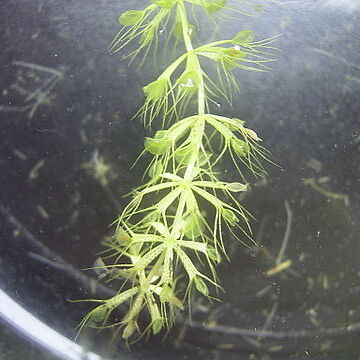Herbs perennial, aquatic, carnivorous, apparently without roots, freely floating during growing season, forming a bulb at shoot tip during winter. Leaves whorled, exstipulate, united at base; petiole cuneate, with 4-8 laciniate bristles; leaf blade articulated at base into 2 segments forming a trap for small, aquatic animals. Stem simple or sometimes branched, with sensitive hairs and numerous digestive glands. Flower axillary, solitary on short scape 0.5-1.5 cm. Sepals 5, united at base, ovate-elliptic to elliptic-lanceolate, 2-4 × 1-1.5 mm. Petals 5, white or greenish white, oblong. Stamens 5, 3-4 mm; filaments subulate. Ovary superior, subglobose, 5-carpellate; styles 5; stigma multifid. Capsule subglobose, indehiscent. Seeds 5-8 or fewer, ovoid-globose.
Rootless, submersed, floating aquatic plant, with simple or seemingly forked stem. Leaves in whorls of 7-9, connate at the base. Blade articulated, upper surface irritable by hairs and provided with glands; petiole swollen, lacunose, the apex bearing subulate dentate segments; blade reniform to orbicular when flattened, reduced in the flowering whorl and sometimes the foregoing one. Flowers solitary, axillary. Pedicels robust, reflexed in fruit. Sepals 5, imbricate, coherent at the base. Petals white, originally calyptrately connivent. Styles 5, filiform, patent, incurved, apex dilitate and penicillate. Capsule 5-valved.
Ovary 5-carpellary; styles 5, free, digitately branched at the apex; ovules on 5 parietal placentas.
Leaves in whorls, the lamina articulate, reduced in the flowering whorl.
Capsules with 5 valves; seeds 6–8, ovoid, black.
Submerged floating aquatic plant, without roots.
Flowers solitary, axillary, emergent.
Stems simple or branched.
Sepals and petals 5.
Stamens 5.

